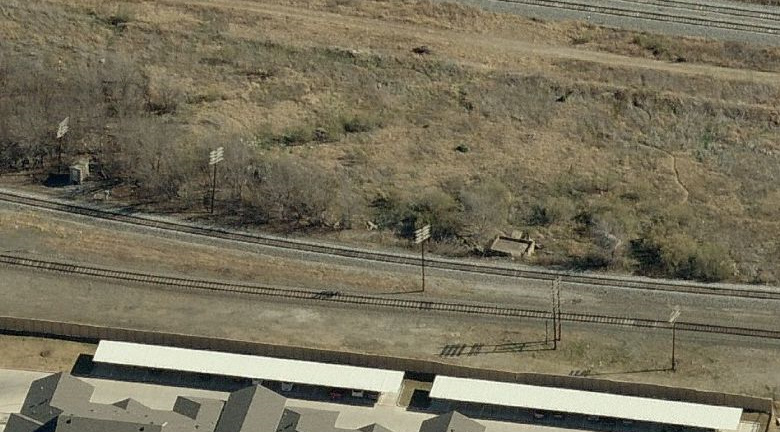Texas Railroad History - Tower 53 (Ney Yard), Tower
124 (Bird's Siding) and Tower 126 (Polk's Tower) - Fort Worth
Three Towers in South Fort Worth
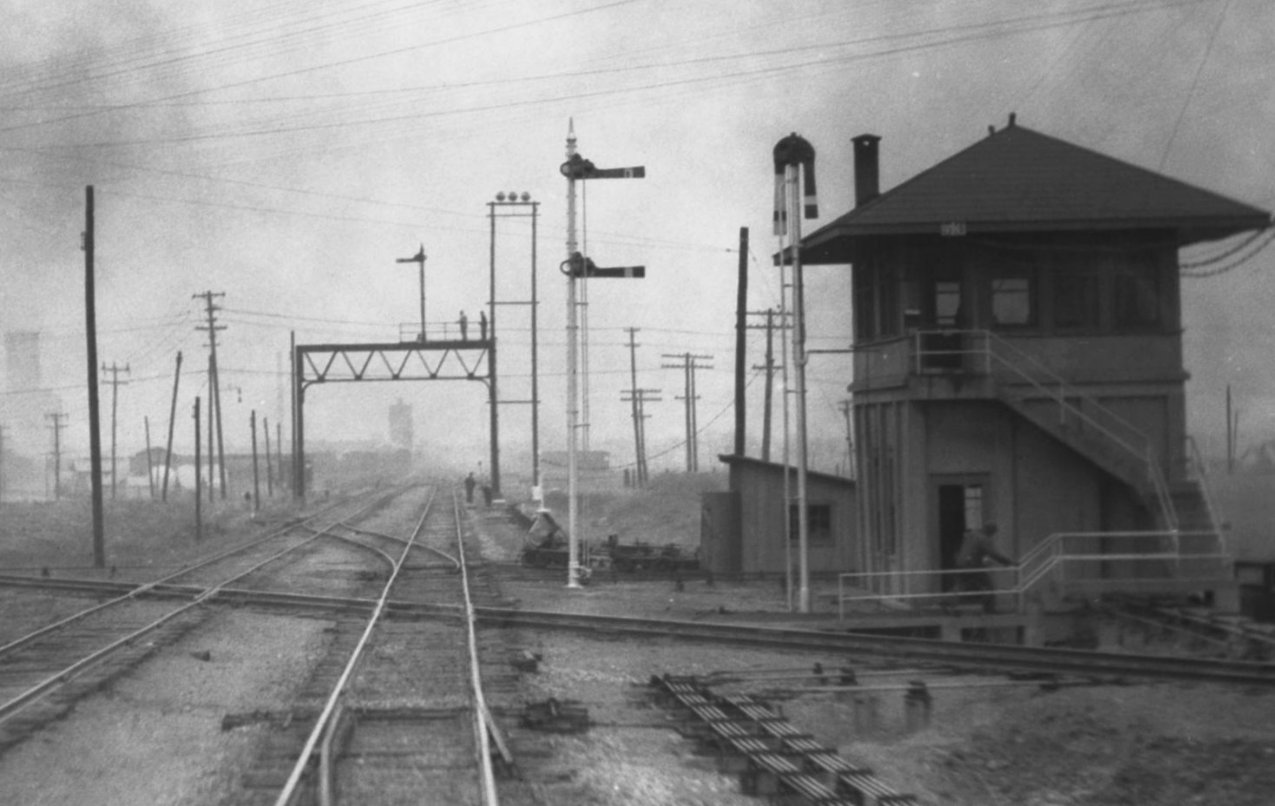
Above: John W. Barriger
III took this photo of Tower 53 sometime in the 1930s or 40s from the rear
platform of his business car as he headed south out of Fort Worth on the
Missouri - Kansas - Texas ("Katy") Railroad main line. The view is to the north
where the Southern Pacific (SP) tracks from Garrett crossed the Katy at the
tower. By appearance, the tower must have been a Katy design as it lacked the typical paint
scheme, trim and other features common to the numerous SP towers built in the 1903-04 timeframe (e.g.
Tower 26, Tower 81, etc.) The small sign hanging from the
roofline above the upper floor landing is not legible (any guesses?) but it
doesn't appear to be the tower number, nor is the number apparent elsewhere on the structure.
There are several people visible in the photo. How many can you count?
(John W. Barriger National Railroad Library)
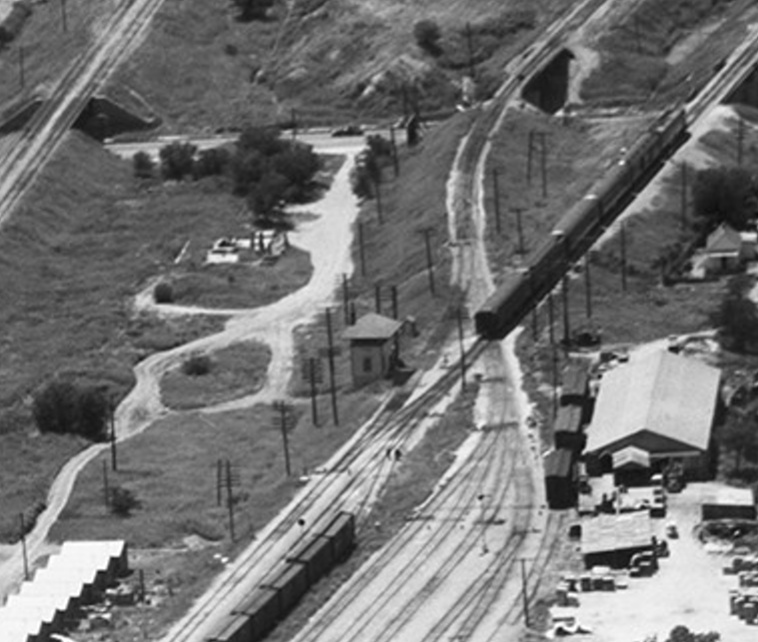 |
Left: This image is taken from a larger aerial
photo looking south from just south of downtown Fort Worth in 1952.
Tower 126, commonly known as Polk's Tower, is visible immediately east
and barely north of a crossing of the Gulf, Colorado & Santa Fe (GC&SF)
Railway and the Texas & New Orleans (T&NO) Railway. The train is heading
south on the Santa Fe tracks and is about to cross the bridge
over Rosedale St., just as its last car is clearing the diamond at
Polk's Tower. The Katy's main line is visible at far left with its
bridge over Rosedale. The T&NO bridge is visible between the Katy
and Santa Fe bridges. Magnification of the tower (below) does not
convey enough detail to provide conclusive evidence of which
railroad built it. (W. D. Smith c.1952, courtesy UT Arlington Libraries,
hat tip Doug Sutherland and Jim Gibson)
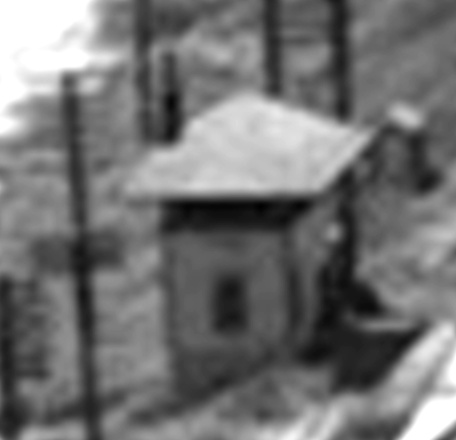 |
On December 1, 1880,
railroad magnate Jay Gould leased one of his properties, the Missouri - Kansas -
Texas ("Katy") Railroad, to another of his properties, the Missouri Pacific (MP)
Railroad, giving MP its first operations in Texas. The Katy had reached Ft.
Worth earlier in the year using rights from Whitesboro on a line it shared with the
Texas & Pacific (T&P), another Gould railroad. The Katy's base was at
Denison where it had crossed the Red River in 1873. A Denison -
Gainesville line
built in 1879 gave the Katy tracks through Whitesboro, and in 1880, the T&P intentionally routed its
Sherman - Fort Worth
construction via Whitesboro so the new tracks to Ft. Worth could be
shared. The Katy built a yard in south Ft. Worth that (at least by 1917) was called "Ney Yard".
The Katy continued construction south from Ft. Worth, reaching Taylor
by 1882. Gould (and MP) subsequently lost control of the Katy during a
receivership in 1888. It eventually emerged from bankruptcy as an independent
railroad, and it remained that way for the next hundred years.
By the time the Katy began building south into the heart of Texas, the Gulf,
Colorado & Santa Fe (GC&SF) Railway was already four years into building north
from Galveston. By 1880, it had made only limited progress to
Brenham, but
a flurry of construction the following year resulted in tracks from Brenham to
Temple and from Temple to Fort Worth. Santa Fe's
tracks coming into Fort Worth were west of the Katy's, but both railroads passed
parallel through a major junction with the T&P's east/west main line near
downtown. In 1886, the GC&SF
agreed to be acquired by the much larger Atchison, Topeka & Santa Fe Railway,
but continued to operate as a wholly owned subsidiary.
In 1885, Fort Worth
investors chartered the Fort Worth & New Orleans (FW&NO) Railway, ostensibly to
build to New Orleans, but in reality to build to Waxahachie.
From there, existing tracks of the Waxahachie Tap Railroad provided a connection
to the main line of the Houston & Texas Central (H&TC) Railway at Garrett.
The FW&NO began construction in September, 1885 at Broadway Street where they
established their yard west of the Katy and Santa Fe tracks about 500 yds.
south of the T&P junction. At the south end of their yard, the FW&NO built
across the Santa Fe main line. For the Polk Brothers, this junction of two
railroads seemed to be the ideal spot for their new stockyard. At a 2017 presentation for the Society of Historical Archeology in Fort
Worth, Harding Polk II summarized the history of Polk's Stockyard, which was
founded by his grandfather, James Hilliard Polk, a cousin of U. S. President James K.
Polk.
Brothers James Hilliard Polk and
Lucius Junius Polk banded together to form the Polk Brothers Livestock
stockyards of Fort Worth. Established in 1885 they were the first stockyard in
Fort Worth. They were located south of the present Fort Worth Union stockyards
and situated conveniently at the intersection of two rail lines. One notable
contract they received was to supply the British Army with horses and mules
during the Boer Wars in South Africa at the turn of the twentieth century.
Around 1914 the stockyards burned, ending the enterprise.
To head for Waxahachie, the FW&NO needed to build
southeast out of Fort Worth, but the presence of Ney Yard prevented the FW&NO
from crossing over the Katy near Broadway Yard. Instead, they built
south for a mile before curving southeast to
cross the Katy beyond the south end of Ney. This crossing was probably
built in the fall of 1885 because, according to Fort
Worth lore, locals had already nicknamed it "Buttermilk Junction" by the time a famous railroad gun
battle broke out in April, 1886. The following year, the FW&NO was acquired
by the H&TC, which by then was owned by Southern Pacific (SP). In 1901, the
Legislature authorized H&TC to merge both the FW&NO and the former Waxahachie
Tap railroad (which had been renamed in the interim) into a single H&TC branch. The H&TC continued
operating as a wholly-owned subsidiary until it was leased by (1927) and
merged into (1934) the Texas & New Orleans (T&NO) Railroad, SP's
primary operating company in Texas and Louisiana.
Shortly after the
FW&NO's construction to Waxahachie got started, the newly
chartered Fort Worth & Rio Grande (FW&RG) Railway began building
southwest out of
Ft. Worth. Financing was largely provided by the
Vanderbilt syndicate which had dreams of extending it to the Pacific Ocean
harbor at Topolobampo, Mexico. Construction began in 1886 near the T&P tracks at
Hemphill St. and (what is now) Vickery Blvd. The FW&RG line finally reached
Brownwood in 1891, and that same year, the FW&RG built a spur in Fort Worth for interchange with
the Katy and the H&TC. It departed the main line at a location later called Belt
Junction and ran due east to the Katy tracks before turning north to the
Katy/H&TC crossing. About midway between Belt Junction and the Katy tracks, the
spur crossed the Santa Fe main line to Temple at a location known as "Bird's Siding".
By 1888,
Santa Fe had expanded west from Temple through Brownwood to
San Angelo to pursue livestock shipping from a vast, sparsely populated
area of cattle and sheep ranches. This put Santa Fe in direct competition with the
FW&RG which was in the midst of building from Fort
Worth to Brownwood. Although they competed, the two companies also cooperated in
livestock shipments. It was not uncommon for Santa Fe livestock cars to be
handed over to the FW&RG in Brownwood for transport to Bird's Siding where they
would be handed back to Santa Fe. The FW&RG route was 117 miles shorter from Brownwood to Fort Worth
than Santa Fe's route through Temple. Time and distance were important for livestock shipments because the
law required railroads to perform feeding and watering at specific intervals. Ultimately,
it made sense for Santa Fe to own the Fort Worth - Brownwood line, so they
purchased the FW&RG in 1937. The seller was the St. Louis San Francisco
("Frisco") Railway which had acquired the FW&RG in 1901. The sale did not include tracks north of Belt Junction as
these led to Frisco's yard, but the sale may have included the spur. Santa Fe needed
the spur tracks between Bird's Siding and Belt Junction to connect the Brownwood line
to their Fort Worth track network, but the Frisco needed the entire spur so they
could continue to interchange with the Katy and the H&TC. Which railroad
owned the spur and which had rights on it has not been determined.
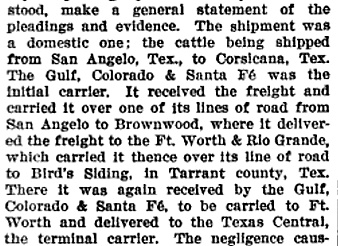 |
Left: This excerpt from court records of a 1902
damages lawsuit against the FW&RG and Santa Fe shows how a
cattle shipment from San Angelo to Corsicana involved interchanges at
both
Brownwood and Bird's Siding.
Right: Facing south toward the Santa Fe crossing at W. Biddison St., this 2002 photo shows an older style equipment cabinet.
The
word below "West End" on the side is "Bird's". The cabinet was
most likely associated with the siding switch. (Jim King photo) |
 |
In 1903, the
International & Great Northern (I&GN) Railroad finished a main line from Waco
to Fort Worth that passed over the H&TC on a bridge a mile southeast of the Katy/H&TC
crossing. From just south of the bridge, the I&GN built an interchange track
that paralleled the H&TC tracks all the way to the crossing. Like the
FW&RG, the I&GN made connections and perhaps maintained sidings at the junction,
but they did not cross any other railroad; only the H&TC and Katy actually
crossed. This was significant because in July, 1901, a new state law mandated
interlockers for busy railroad crossings. On July 23, 1904, the Railroad
Commission of Texas (RCT) authorized Tower 53 to begin operations at this
crossing which RCT officially listed as "South of Ft. Worth". The interlocking
plant was built by Union Switch & Signal Co. and was configured for twelve
active functions. For most towers, twelve was the minimum, usually a home signal
in each direction, a distant signal in each direction, and a mechanical derail
in each direction. In 1923, RCT's published list of
interlockers added the FW&RG and I&GN as official participants at Tower 53 (and
the function count rose to 25), but the associated track and signal changes have not
been determined. In RCT's list dated December 31, 1926, Tower 53's location was
revised to "Ft. Worth, Ney Yards" but all other information remained unchanged.
One year later, the location changed again, to "South Ft. Worth
(Ney)", and this was RCT's final revision. In 1931, RCT stopped publishing
an annual list of active interlockers.
North of Tower 53, the Katy and
Santa Fe junction with the T&P near downtown was also interlocked in 1904 with
Tower 55. It then took more than twenty years for the crossings at Polk's
Stockyard and Bird's Siding to become interlocked. The first of the two was Tower 126 at Polk's on June 15, 1926.
Commonly known to railroaders as Polk's Tower, it was a two-story manned tower
that housed an electric interlocker with 33 functions. RCT's annual list of
active interlockers published December 31, 1926 cites Tower 126 as being located
at "Fort Worth, Polk's Stock Yard". The following year, the report started
calling the location "Ft. Worth (Violet St.)", a street that no longer exists.
(Perhaps the change resulted from RCT realizing that Polk's Stockyard had been
out of business for thirteen years due to the fire in 1914!)
Documents in the RCT interlocker archives at DeGolyer Library, Southern
Methodist University indicate that Polk's Tower was approximately 14 ft. by 20 ft.
in size.
The image of Polk's Tower at the top of this page is the only image of it that
has ever been found.
For the FW&RG/Santa Fe crossing, RCT commissioned a
cabin interlocker, Tower 124, at "Fort Worth, Bird's Siding" on November 2,
1926. Cabin interlockers were unmanned huts operated by train crews, typically
used where a busy line (e.g., the Santa Fe) crossed a less active line (e.g.,
the FW&RG spur.) The interlocker was normally set to allow unrestricted
movements on the busier track. When a train on the less active line needed to
cross, it would stop short of the diamond and a crewmember would enter the cabin
and the set the controls to allow his train to pass. During that brief period,
trains on the busier line would see a signal to stop if they approached the
crossing. Once the crewmember's train had crossed, he would reset the signals to
allow unrestricted movements on the busier track. RCT's published list of
current interlockers dated December 31, 1926 shows Tower 124 having six active
functions. This was half the normal minimum because signals and derails were
only needed on the busier line. Train crews on the lightly used line always
stopped, hence fixed signs along that right-of-way were sufficient. RCT's
interlocker list dated December 21, 1928 changed Tower 124's function count to
seven, but the details of that change have not been determined. When the Frisco merged with Burlington
Northern (BN) in 1980, Frisco's operations shifted to BN's primary Fort Worth &
Denver yard on the north side of town. The former FW&RG spur east of Bird's
Siding was no longer needed and was removed in 1983, but the western part
between Bird's Siding and Belt Junction remained intact for Santa Fe access to
the Brownwood line. In 1994, Santa Fe sold the Brownwood line and it eventually
became owned by the Fort Worth & Western Railroad (FW&WR).
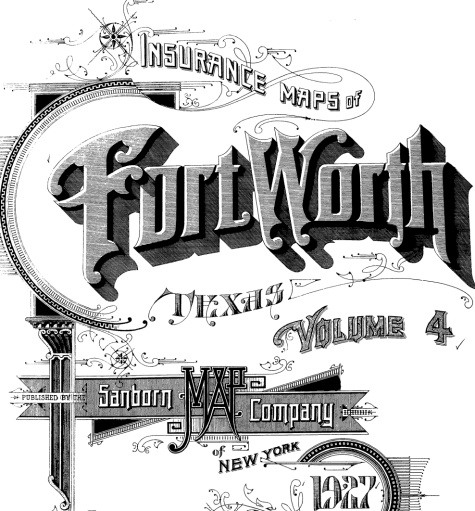
Right: This index for the 1927 Sanborn Fire
Insurance Co. Fort Worth map set has been
annotated to show the tracks of the railroads near Tower 53, Tower 124
(Bird's Siding) and Belt Junction (Polk's Tower is off the top of the
map.) Katy Lake and I&GN Lake have also
been highlighted in green, examples of the common practice of steam era
railroads building their own reservoirs. Katy Lake was built in 1907-08 and
survived until 1959 when it was drained as part of the construction of a
large shopping center. I&GN Lake was probably built in 1903 when the I&GN
began serving Ft. Worth. It survives today as Echo Lake. |
 |
MP acquired the I&GN
(1925) and gained controlling interest in the T&P (1930); the two railroads
became fully merged into MP in 1956 and 1976, respectively. By 1952, the I&GN
interchange track to Tower 53 had been removed; the right-of-way was repurposed as Cole St. along the south side of Echo
Lake (formerly I&GN Lake) in the 1970s. In 1967-68, MP abandoned the I&GN route
between Waco and Fort Worth, but the former I&GN tracks in Fort Worth are
still intact
north of Everman, a
community in southeast Fort Worth.
On March 20, 1961, RCT
wrote a letter to Santa Fe, T&NO and the Frisco confirming that "Polk's Interlocking" had been officially retired.
(The
Frisco involvement may have been related to trackage rights; it did not have
tracks at Polk's Tower.) T&NO and Santa Fe knew firsthand that they had
removed the
interlocker as this was the culmination of their plan to solve a switching problem. Kal Silverberg explains why the
crossing was removed:
"...a track swap was arranged between SP [T&NO] and Santa Fe, most likely due to SP
not being able to switch at their yard because Santa Fe trains were blocking the
lead. The diamond at Polk's was removed and the roads swapped tracks. A new
diamond was placed underneath the Allen Avenue bridge and the tracks swapped
back. This gave SP more room to switch at the south end of Broadway Yard and led
to the confusing state where Santa Fe used the SP bridge over Rosedale, and SP
used the Santa Fe bridge. There was a hand throw connection to the Katy from the SP just south of the diamond under Allen Avenue. The new
diamond was protected by automatic signals, but appears to have never
been under control of any tower. Since this diamond and Tower 53 were
not interconnected, it was possible for the SP to have a green signal at
Tower 53 (once it was automated), a red signal at the new diamond, and,
if the train was long enough, still block the Katy main line until they
could pull into Broadway Street Yard."
This track topology remained in place into the latter
1990s by which time railroad consolidations had rendered it obsolete.
In 1982, MP was acquired by Union Pacific (UP) but remained a subsidiary
corporation. In 1988, UP acquired the Katy and consolidated it into MP,
reuniting the two railroads a hundred years after MP's lease was dissolved
during the Katy's bankruptcy. In the summer of 1996, UP acquired SP and within a
couple of years, UP had integrated MP and SP into its national rail operations. In late
1996, Burlington Northern merged with Santa Fe, creating Burlington Northern
Santa Fe (BNSF). While the BNSF merger had no practical effect on the
tracks near Polk's, UP's efforts to combine SP and MP/Katy operations in Fort
Worth resulted in the elimination of SP's Broadway Yard. And with no need for
the SP tracks to reach Broadway, there was no reason to retain
the Tower 53 crossing which served no other purpose (since the I&GN and FW&RG
were no longer there.) Instead, the former SP track coming in from the southeast
was routed northward into the south end of Ney Yard.
No longer called "Buttermilk Junction" (if it ever was by the railroads
- no railroad sources using that name have been found), "Midlothian Junction" is
the current name for the switch that leads to Waxahachie and beyond.
The elimination of Tower 53 isolated the SP
track west of the Katy -- the north end couldn't terminate at Broadway Yard (abandoned), and the south end no longer crossed at Tower 53 (removed).
To make productive use of this track, UP routed both ends back onto the main line in their
respective directions, effectively creating a "Ney Bypass" around the west side
of Ney Yard. Accomplishing this, however, presented a problem
-- north of Allen Ave. the Santa Fe tracks
were east of the SP track, i.e. between the SP
and the Katy. To merge the north end of the SP track onto the Katy toward Tower
55, the SP track needed to cross back over to be east of the Santa Fe. A simple solution was available -- eliminate the crossing beneath Allen
Ave. and swap tracks. An agreement to do so was arranged between UP and BNSF, and now there is no crossing at all.
The track alignments have become consistent with their pre-1961 heritage except
that north of the location of Polk's Tower, Santa Fe has the west track and UP
the east track.
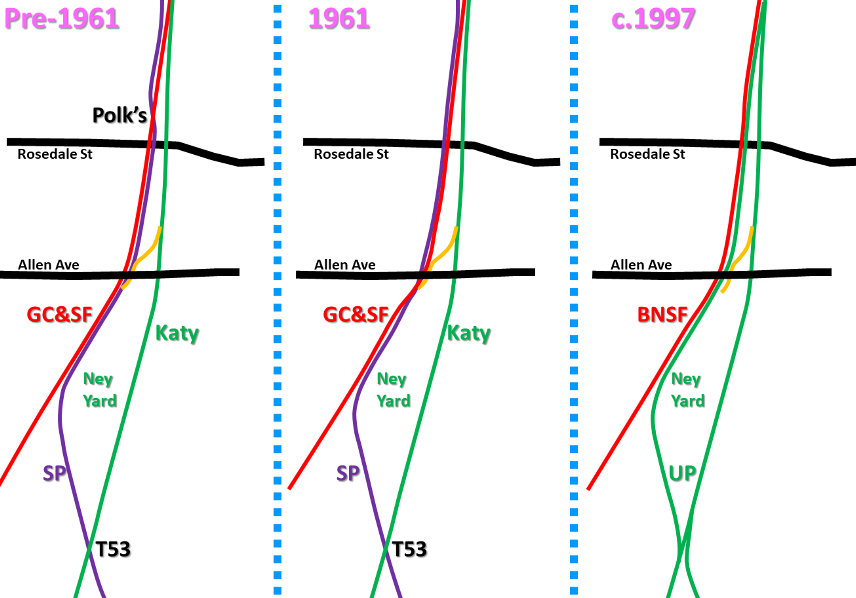
Above: These three diagrams depict the track changes
associated with Polk's Tower, Allen Ave. and Tower 53. In the original configuration
(left), the SP tracks crossed the Santa Fe at Polk's Tower at the south end of
SP's Broadway Yard. This is the track arrangement visible in the tower image at
the top of the page (but note that the tower image has south "up" while the
graphic above has north "up".) In 1961 (center), Polk's Tower was eliminated and
the crossing was moved to beneath the Allen Ave. bridge where an automatic
interlocker was installed. This allowed SP to switch cars at their Broadway Yard
without being blocked by Santa Fe trains. Around 1997 (right), the Allen Ave.
crossing was eliminated and the tracks were swapped north of there. This is now
UP's Ney Bypass. Trains on UP's main line to or from the south that do
not need to go into Ney Yard can take the bypass around the west side of the
yard. The Katy "hand throw connection" (orange) referenced above by Kal serves a
business adjacent to the Ney Bypass but does not connect to the Bypass track.
Below: This
Google Maps simulated 3-D view is to the south, approximating the view in the
1952 aerial photo of Polk's Tower at the top of the page. There are now five bridges over Rosedale St. The double tracking
of the BNSF line required an additional bridge, and there is now a service road
bridge adjacent to the Katy bridge at left. Google Maps' 3-D algorithm, which combines satellite imagery with terrestrial elevation
data, imparts a visible base to what appears to be a concrete slab adjacent to
the tracks. Whether this is the foundation of Polk's Tower has not been
confirmed, but the location is plausible.

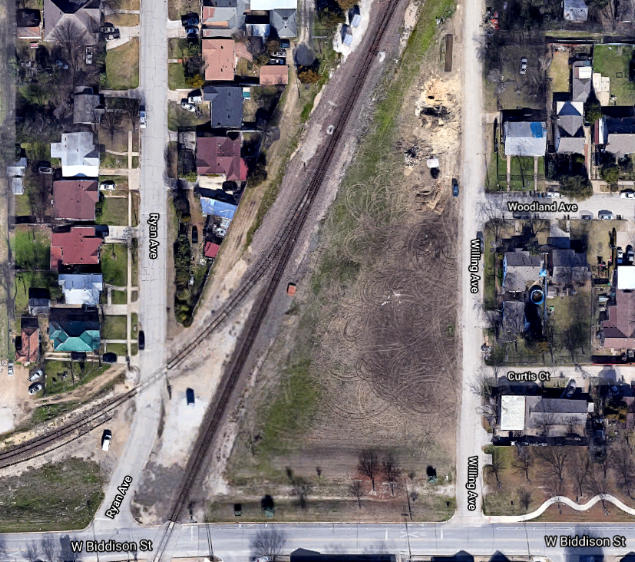
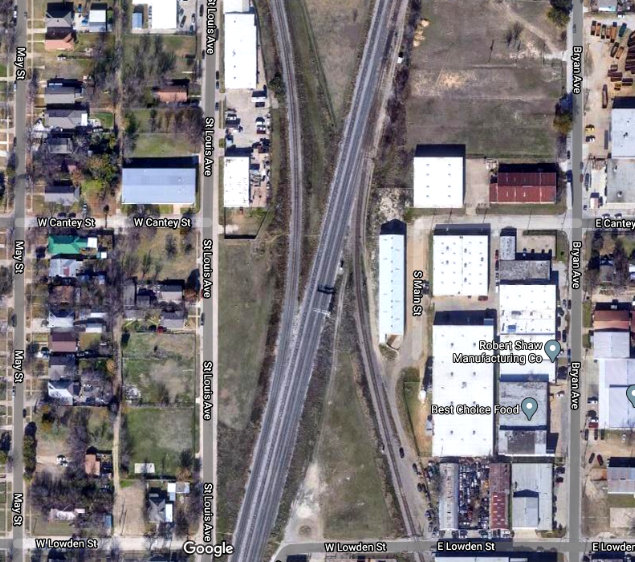
Above Left: This recent Google Earth satellite image of
the crossing at Bird's Siding shows that the connector in the northwest quadrant
is still in use. The FW&RG spur to Tower 53 ran along the north side of W. Biddison St., so the actual diamond would have been barely north of Biddison
and east of Ryan Ave. From this view, it is easy to envision the (unconfirmed!) possibility
that livestock pens were located in the open area on the east side of the Santa
Fe tracks. When livestock was exchanged here, it may have been appropriate to
perform feeding
and watering since some delay was likely to occur anyway to effect
the transfer. Above Right:
This recent Google Earth satellite image of the Tower 53 crossing shows that the
tracks no longer cross. Instead of crossing, the SP lines reach both sides of
the Katy tracks and merge in opposite directions. The tracks on the east side
merge north. The tracks on the west side merge south, and in the other
direction, they proceed northwest away from the Katy tracks, eventually becoming
adjacent and parallel to the BNSF main line as they continue north to the site
of the former Polk's Tower and beyond to Tower 55.
Below Left: ((c) historicaerials.com)
This 1956 image of the Bird's Siding crossing does
not show any evidence of how the vacant area east of the Santa Fe tracks was
used. It's evident from the image that the location of the equipment cabinet at "West End,
Bird's" is too far north of the diamond to have been the site of the
interlocker cabin. A 1964 GC&SF timetable implies that Bird's Siding had
become an
automatic interlocker by then.
Below Right: About 1957,
Tower 53's interlocking plant was automated, but
this 1963 aerial
image ((c) historicaerials.com) shows that the tower remained standing, casting a shadow to
the north. The tower could have remained manned for some other purpose, or perhaps
it was merely used as storage or to host electronic equipment. Later
imagery shows the tower was gone by 1968; its fate has not been determined.
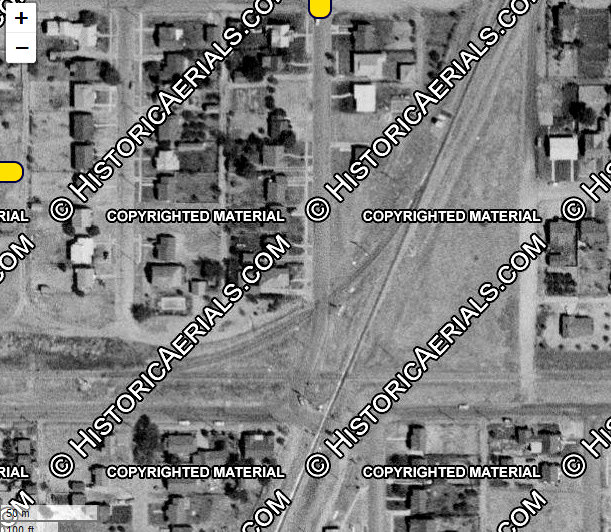
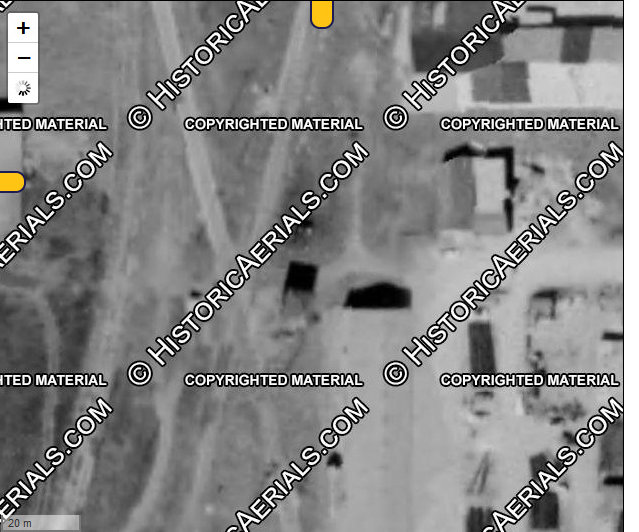

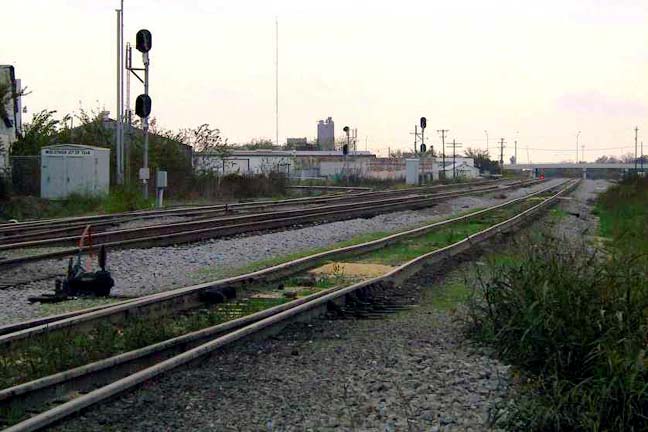
Above Left: Facing northwest at the Tower 53 crossing, the former SP line comes
in from the southeast and joins the main track into Ney Yard.
(Jim King, c.2005)
Above Right: The switch at Tower 53 is now known as Midlothian Jct.
In this view, Tower
53 would have been visible across the Katy tracks. (Jim King, c.2005)
Below Left: Looking southeast
from the W. Morningside Dr. grade crossing,
the former SP tracks now curve to the south instead of crossing the Katy main
line. (Google Street View) Below Right:
Looking northwest, the former grade of the I&GN spur now carries Cole St. along
side Echo Lake, the former I&GN reservoir. (Google Street View)
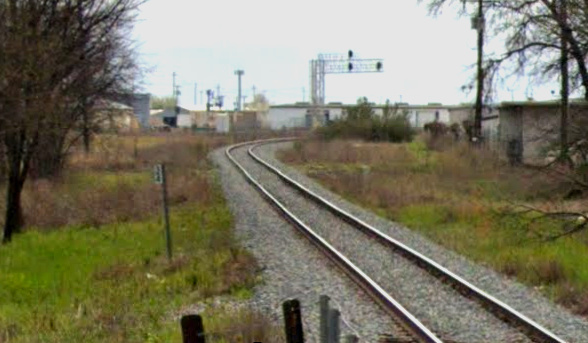
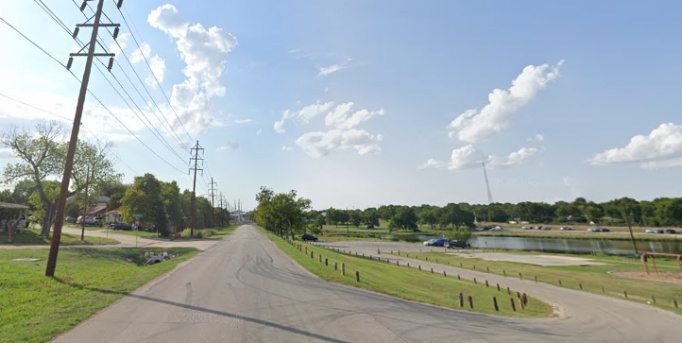
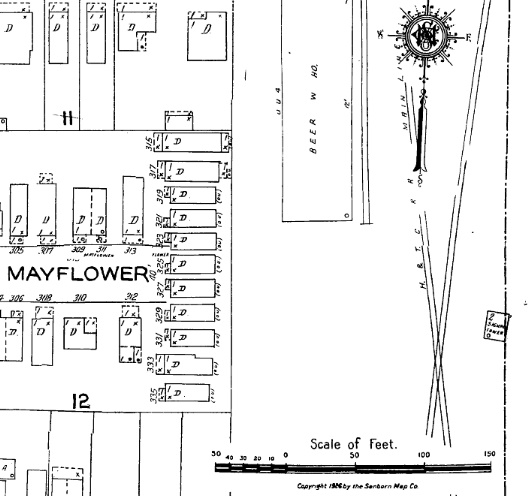
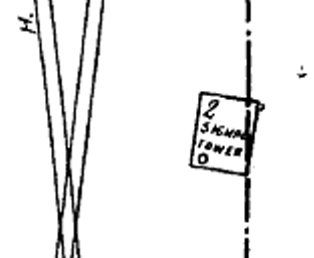
Above: The 1951 update to
the 1910 Sanborn Insurance Co. map of Fort Worth shows a two-story signal tower at the Polk's Tower crossing.
The tower was part of the update since it did not exist until 1926.
Below Left: This
trackside concrete equipment cabinet is labeled "West End, Polk's".
Since the lines no longer crossed, there may
not have been any continuing purpose for the cabin and the control box
when this photo was taken in 2002.
(Jim King photo) Below Right:
The cabinet is still standing in this December, 2019 satellite view.
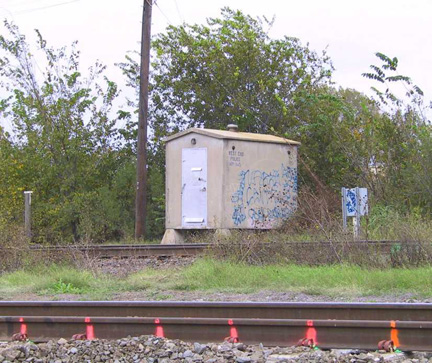

Below Left: Facing
east, this c.2002 bird's eye view of the
vicinity of Polk's Tower shows the equipment cabin (above) sitting at the edge of the brush, adjacent to the utility pole that is
also visible in the above photo. Of greater interest
is the potential remnant of the tower's foundation sitting trackside. Note that the path of the utility
poles traces the original route of the Santa Fe right-of-way, undeterred by the
swapping of main lines. (Microsoft Visual Earth)
Below Right: This satellite
image from 2019 shows that the Santa Fe line is now double track. The concrete
foundation, possibly of Tower 126, is visible beside the UP track, about 80
yards south of where the cabinet (above) sits.
